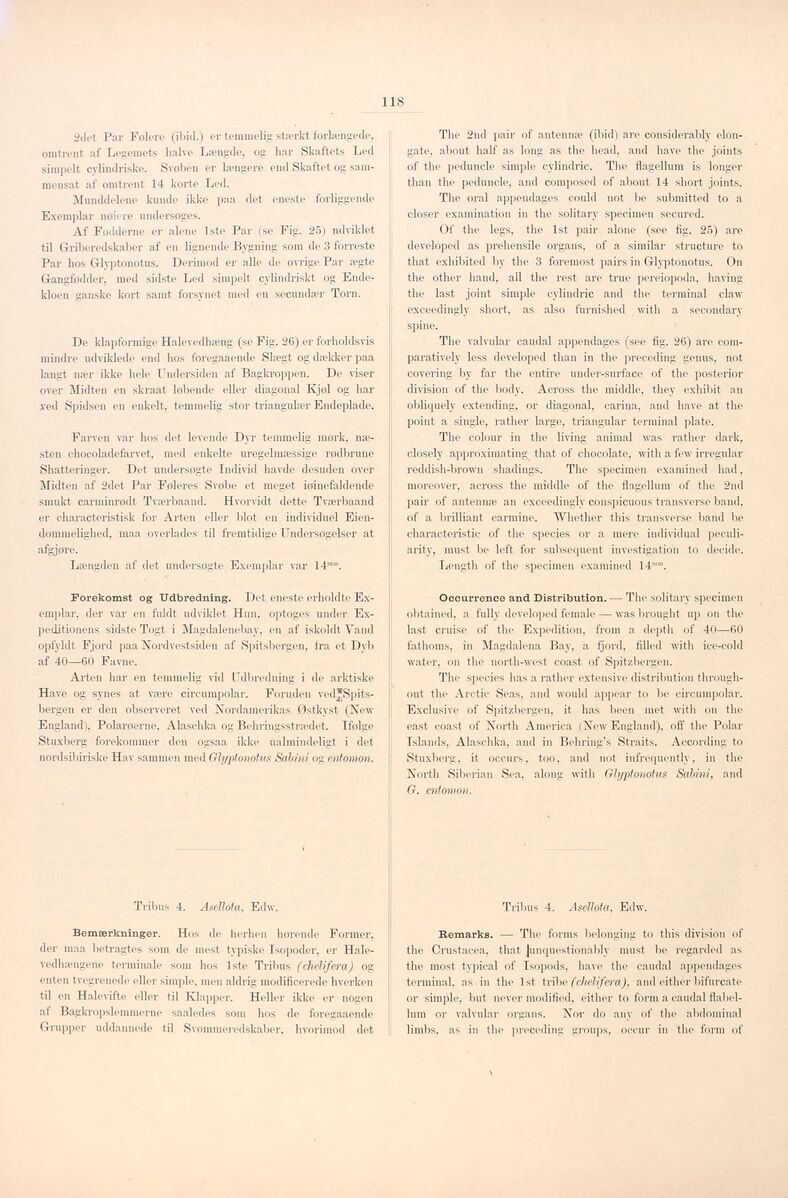
Full resolution (JPEG) - On this page / på denna sida - Sidor ...

<< prev. page << föreg. sida << >> nästa sida >> next page >>
Below is the raw OCR text
from the above scanned image.
Do you see an error? Proofread the page now!
Här nedan syns maskintolkade texten från faksimilbilden ovan.
Ser du något fel? Korrekturläs sidan nu!
This page has never been proofread. / Denna sida har aldrig korrekturlästs.
118
2det Par Følere (ibid.) er temmelig stærkt forlængede,
omtrent af Legemets halve Længde, og har Skaftets Led
simpelt cylindriske. Svøben er længere end Skaftet og
sammensat af omtrent 14 korte Led.
Munddelene kunde ikke paa det eneste forliggende
Exemplar nøiere undersøges.
Af Fødderne er alene lste Par (se Fig. 25) udviklet
til Griberedskaber af en lignende Bygning som de 3 forreste
Par hos Glyptonotus. Derimod er alle de øvrige Par ægte
Gangfødder, med sidste Led simpelt cylindriskt og
Ende-kloen ganske kort samt forsynet med en secundær Torn.
De Hapformige Halevedhæng (se Fig. 26) er forholdsvis
mindre udviklede end hos foregaaende Slægt og dækker paa
langt nær ikke hele Undersiden af Bagkroppen. De viser
over Midten en skraat løbende eller diagonal Kjol og har
red Spidsen en enkelt, temmelig stor triangulær Endeplade.
Farven var hos det levende Dyr temmelig mørk,
næsten choeoladefarvet, med enkelte uregelmæssige rødbrune
Shatteringer. Det undersøgte Individ havde desuden over
Midten af 2det Par Føleres Svøbe et meget iøinefaldende
smukt carminrødt Tværbaand. Hvorvidt dette Tværbaand
er characteristisk for Arten eller blot en individuel
Ejendommelighed, maa overlades til fremtidige Undersøgelser at
afgjøre.
Længden af det undersøgte Exemplar var 14™".
Forekomst og Udbredning. Det eneste erholdte
Exemplar, der var en fuldt udviklet Hun, optoges under
Ex-peditionens sidste Togt i Magdalenebay, en af iskoldt Vand
opfyldt Fjord paa Nordvestsiden af Spitsbergen, trå et Dyb
af 40—60 Favne.
Arten har en temmelig vid Udbredning i de arktiske
Have og synes at være circumpolar. Foruden
vedJSpits-bergen er den observeret ved Nordamerikas Østkyst (New
England). Polarøerne, Alaschka og Behringsstrædet. Ifølge
Stuxberg forekommer den ogsaa ikke ualmindeligt i det
nordsibiriske Hav sammen med Glyptonotus Sabini og entomon.
The 2nd pair of antennæ (ibid) are considerably
elongate, about half as long as the head, and have the joints
of the peduncle simple cylindric. The flagellum is longer
than the peduncle, and composed of about 14 short joints.
The oral appendages could not be submitted to a
closer examination in the solitary specimen secured.
Of the legs, the 1st pair alone (see fig. 25) are
developed as prehensile organs, of a similar structure to
that exhibited by the 3 foremost pairs in Glyptonotus. On
the other band, all the rest are true pereiopoda, having
the last joint simple cylindric and the terminal claw
exceedingly short, as also furnished with a secondary
spine.
The valvular caudal appendages (see fig. 26) are
comparatively less developed than in the preceding genus, not
covering by far the entire under-surface of the posterior
division of the body. Across the middle, they exhibit an
obliquely extending, or diagonal, carina, and have at the
point a single, rather large, triangular terminal plate.
The colour in the living animal was rather dark,
closely approximating that of chocolate, with a few irregular
reddish-brown shadings. The specimen examined had,
moreover, across the middle of the flagellum of the 2nd
pair of antennæ an exceedingly conspicuous transverse band,
of a brilliant carmine. Whether this transverse band be
characteristic of the species or a mere individual
peculiarity, must be left for subsequent investigation to decide.
Length of the specimen examined 14n,m.
Occurrence and Distribution.— The solitary specimen
obtained, a fully developed female — was brought up on the
last cruise of the Expedition, from a depth of 40—60
fathoms, in Magdalena Bay, a fjord, filled with ice-cold
water, on the north-west coast of Spitzbergen.
The species has a rather extensive distribution
throughout the Arctic Seas, and would appear to be circumpolar.
Exclusive of Spitzbergen, it has been met with on the
east coast of North America (New England), off the Polar
Islands, Alaschka, and in Behring’s Straits. According to
Stuxberg, it occurs, too, and not infrequently, in the
North Siberian Sea, along with Glyptonotus Sabini, and
G. entomon.
Tribus 4. Asellota. Edw.
Bemærkninger. Hos de herhen hørende Former,
der maa betragtes som de mest typiske Isopoder, er
Halevedhængene terminale som hos lste Tribus (ehelifera) og
enten tregrenede eller simple, men aldrig modificerede hverken
til en Halevifte eller til Klapper. Heller ikke er nogen
af Bagkropslemmerne saaledes som hos de foregaaende
Grupper uddannede til Svømmeredskaber, hvorimod det
Tribus 4. Asellota. Edw.
Remarks. — The forms belonging to tilis division of
the Crustacea, that Junquestionably must be regarded as
the most typical of Isopods, have the caudal appendages
terminal, as in the 1 st tribe fehelifera), and either bifurcate
or simple, but never modified, either to form a caudal
flabel-lum or valvular organs. Nor do any of the abdominal
limbs, as in the preceding groups, occur in the form of
<< prev. page << föreg. sida << >> nästa sida >> next page >>